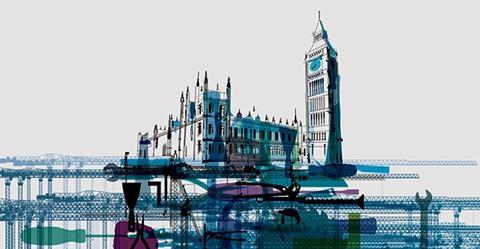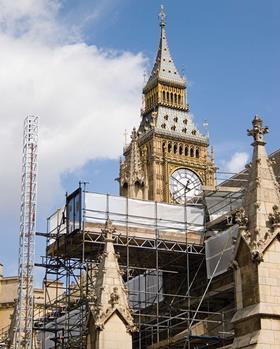Costs are being estimated for the critical repair job needed to the Houses of Parliament - with some suggesting the Palace of Westminster has just 20 years before it’s unusable. But what should happen to MPs while the builders are in?


Hidden below the chambers of parliament lies the Sports and Social Club, where researchers, journalists, caterers and maintenance workers congregate for cheap beer and a game of pool.
This is one of London’s dankest bars and the discreet entrance is hardly made more appealing by the construction work taking place outside. Workers from Shepley Engineers are repairing what are described as “unique” cast iron roofs, while scaffolding hangs from an arch as part of a two-year Mitie project to improve airflow to the debating chambers. Pertinently, information displayed explaining the nature of the latter job adds that this is a “constantly evolving scope of works”, as systems and devices are found that are not on any record drawings.
Rebuilt to Sir Charles Barry’s neo-gothic designs following the 1834 fire that destroyed the original medieval complex (see timeline below), the Palace of Westminster is a Unesco World Heritage Site and a grade I-listed building. But it is in a terrible state of disrepair and slowly sinking into the River Thames - House of Commons speaker John Bercow recently warned that the palace will have to be abandoned within 20 years unless an extensive programme of investment starts soon.
Some, such as hotly-tipped Labour leadership candidate Chuka Umunna, take this as a cue that the time has come to move out of the place altogether. But for most, what is needed is a full-scale restoration programme.
This summer, a parliament-commissioned report by Deloitte Real Estate, consultant Aecom and engineer HOK International will outline options, costs and scope of work needed to salvage one of the world’s great physical symbols of democracy. But, whatever happens, there are likely to be criticisms of the cost and upheaval of the revamp, as well as feuds between politicians over their current and forthcoming working conditions.
The state we’re in
It’s good that there are so many mice around as it means there aren’t any rats
Michael McCann, Former Labour MP
Michael McCann, who led Labour’s Scottish contingent of MPs in the last Parliament, says: “It’s good that there are so many mice around as it means there aren’t any rats”. He once saw a mouse run up a peer’s leg in a tearoom - he thinks the ennobled gentleman did not notice as he was half-asleep - while McCann’s office, in the shadow cabinet block near the Speaker’s Court, was filled with mousetraps.
And working conditions are only getting worse. “If you took a snapshot of the palace in 2010, when I entered parliament, and today, you would really notice the difference,” says McCann. “There is perpetual scaffolding around the building, not just externally but internally as well.”
Graham Brady, the chair of the Conservatives’ powerful 1922 committee, points out that there are areas where there is no mobile phone reception or Wi-Fi access, while a leading Tory backbencher tipped for future office fumes at the “woefully unprofessional, archaic, dysfunctional” facilities and “threadbare IT”. A member of the parliamentary lobby of political journalists says that during 15 years of working in the palace there has “always been building work”; that off the main corridors are rooms filled with disused computers and dust, while the offices are too hot during the summer and freezing in winter, even with the central heating turned right up.
At present, the estate has asked geology experts to look at replacing weathered and disintegrating stone in the palace’s seven courtyards, a job that a source close to the work says will cost in the “low tens of millions”. Some of the stone has been damaged by water from blocked gutters that have not been cleared quickly and vehicles knocking off lumps of brick.
The work involves sourcing pure limestone from Lincolnshire and magnesium limestone from South Yorkshire. A six-year job, this is likely to start later in 2015 and is one of the simpler projects on the estate.

The state to come
The major issues include chronic subsidence that is causing Big Ben’s Elizabeth Tower to lean slightly as the palace sinks into the mud.
The structure of the foundations is largely unknown, while a service tunnel running underneath parliament is crammed with different generations of technology, including telegraph equipment, fixed lines and broadband wiring. A parliamentary source says that two people could, originally, walk alongside each other through this tunnel, but there are now cramped areas where maintenance engineers have to crawl and weave awkwardly in order to do their work.
The Deloitte report will present the parliamentary commissioners, led by Bercow, with a range of ways of salvaging the palace, a job expected to start around 2020. This will include working around MPs and decanting them, either entirely or one chamber at a time.
Few believe that it is realistic that these huge works - which could require an Olympic Delivery Partner-style model to oversee the refurbishment - would be possible with all the politicians and workforce in place.
Angela Eagle, the shadow leader of the House of Commons and a commissioner, says: “It’s getting harder and harder to maintain basic services - the toilets leak, the electricity is a problem, there are plumbing issues, and a lot of asbestos. The view of the facilities people is that we will need to decant - this is a World Heritage Site with more than 2,000 people working in it.”
Although there has been much talk of temporarily, or even permanently, moving politicians to the North (see comment) as a regeneration boost, the reality is that MPs and peers need to be close to the machinery of Whitehall, while their offices in modern, neighbouring Portcullis House and the older Norman Shaw Buildings remain perfectly usable. Moving too far would be costly - which is one of the main reasons why communities department ministers quietly shelved the sale of the Queen Elizabeth II (QEII) conference centre during the last parliament. The centre is about 100 metres from the palace and is the “no-brainer” option given its size and flexibility.
As a commercial venture, the QEII centre is no money spinner and, as it is in state hands and is nearby, is by far the most realistic place to relocate politicians.
However, a row is brewing over the method of decantation. Many MPs want to remain within the splendour of the palace and think that refurbishing one chamber at a time is the preferable idea - provided they get to use the Lords’ red benches when the Commons’ work takes place. “We should assert our constitutional authority and move out the Lords,” says a senior Tory MP.
It’s getting harder and harder to maintain basic services - the toilets leak, the electricity is a problem, there are plumbing issues, and a lot of asbestos
Angela Eagle, Labour MP
One of the great privileges of being an MP is speaking in the House of Commons, but there is a growing fear that a full decampment will mean that one-termers elected in 2020 might not even speak there. A source at a leading construction company that is hopeful of eventually overseeing the revamp says that the restoration could take “a parliament-and-a-half” - seven-and-a-half years.
Moreover, the very much guesstimated cost, which has already increased from £2bn to £3bn, is almost certainly wrong. The poverty of the architectural records means there could be plenty of unforeseen problems during the work, and already it is known that the extent of the asbestos in the building is worse than was feared. The source is convinced the final price will be closer to £4bn - a large sum for the public to accept for the benefit of MPs after years of austerity - and the eventual bill could end up even higher.
Then there is the work on the Thames Tideway project to improve London’s overflowing sewage system, much of which will take place within a few hundred metres of the palace.
“There will be a tunnel boring machine displacing silt and sand and no one’s sure about parliament’s foundations and so no one’s sure what would happen,” says a leading infrastructure expert. “Say a tunnel breaches, does Big Ben then fall over?”
The result
The Houses of Parliament are in a state of disrepair that would be unimaginable to the politicians and special advisers on Capitol Hill in Washington. The offices are not fit for purpose and the IT is a running joke for an internet age.
If the UK wants the Palace of Westminster to remain the country’s home of democracy the taxpayer will have to shell out billions of pounds and MPs will have to accept a longer than expected period of loss of grandeur. Otherwise, the country will simply have to accept that the Houses of Parliament are not fit for working politicians and that today it is better used as a full-time tourist attraction.
Timeline: Palace of Westminster history
Early 11th century
King Cnut starts building on the site where the Palace of Westminster now stands
1042
Edward the Confessor is crowned and starts building Westminster Abbey, which is next to Parliament
1097
New Palace Yard was built by William II - below it today is a five-storey car park with space for 450 cars - who also lays the foundations of Westminster Hall, then known as the Great Hall
1184
The first recorded mention of St Stephen’s Chapel, later rebuilt by Edward I in the late 13th century
1270
Exchequer buildings are built around the Great Hall. The first recorded mention of a royal throne in the hall came 25 years earlier
1341
The Commons and Lords start to meet separately, though the former did not have a recognised chamber of its own until 1547 when it was granted permanent use of St Stephen’s Chapel
1365
The three-storey Jewel Tower, one of a handful of surviving sections of the medieval palace, starts its one-year construction. For two centuries from the 1600s it contained the records of the House of Lords
1512
Henry VIII makes the palace the permanent home of Parliament
1605
Guy Fawkes is caught in the Gunpowder Plot and hanged in the Old Palace Yard, which was built during medieval times
1707
Christopher Wren improves the Commons’ chamber to allow space for Scottish members
1801
James Wyatt takes down ancient paintings and fittings to make space for Irish members to sit in the Commons
1834
The Great Fire destroys most of the original palace - Westminster Hall is among the few surviving parts of the medieval palace. Sir Charles Barry designs the palace the country knows today
1940
Both Houses of Parliament meet in Church House by Westminster Abbey between 1940 and 1941 for fear of bombing - the palace was damaged by 14 air raids during the Second World War
1941
The Commons chamber is destroyed by fire from the bombing, but the Lords and Westminster Hall survive
1950
The Commons moves back to its new chamber
1981
A restoration programme starts, including stone clean-up, that takes 13 years
2013
Deloitte Real Estate, Aecom, and HOK are appointed to work out how to save the palace and their contract is renewed the following year. They will report in June or July this year




























No comments yet